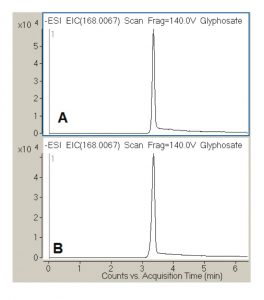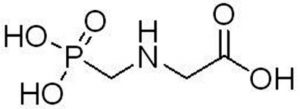Retention of an Extremely Polar Compound
A reliable Method for the determination of Glyphosate is presented. This Method provides very reproducible Retention and fast equilibration even when a Gradient analysis is used. The use of LCMS detection avoids time-consuming derivatization of this compound which is lacking a chromophore for UV detection. The Method shown, with ANP Retention avoids derivatization.
Figures
—A: Injection #1, RT = 3.365 minute
—B: Injection #5, RT = 3.366 minute


Peak:
Glyphosate: 168.0067 m/z (M-H)-
Method Conditions
Column: Cogent Diamond Hydride™, 4μm, 100Å
Catalog No.: 70000-15P-2
Dimensions: 2.1 x 150mm
Mobile Phase:
—A: DI Water / 5mM Ammonium Acetate
—B: 90% Acetonitrile / 10% DI Water / 10mM Ammonium Acetate
Gradient:
| Time (minutes) | %B |
| 0 | 80 |
| 1 | 80 |
| 1.1 | 5 |
| 5 | 5 |
| 6 | 80 |
Post Time: 5 minutes
Flow rate: 0.5mL / minute
Detection: ESI – neg – Agilent 6210 MSD TOF Mass Spectrometer
Sample Preparation: Sample Stock Solution was purchased from Sigma (1000mcg / mL). Sample for analysis was made by diluting the stock 1:100 in 30:70 solution A and B
Notes: Glyphosate is a nonselective herbicide and is used for the control of a wide range of weeds. It is strongly retained on soil components and due to its long half life and solubility in water can be detected long after application or far away from the application site.
Attachment
No 89 Glyphosate Analyzed by LCMS pdf 0.2 Mb Download File


